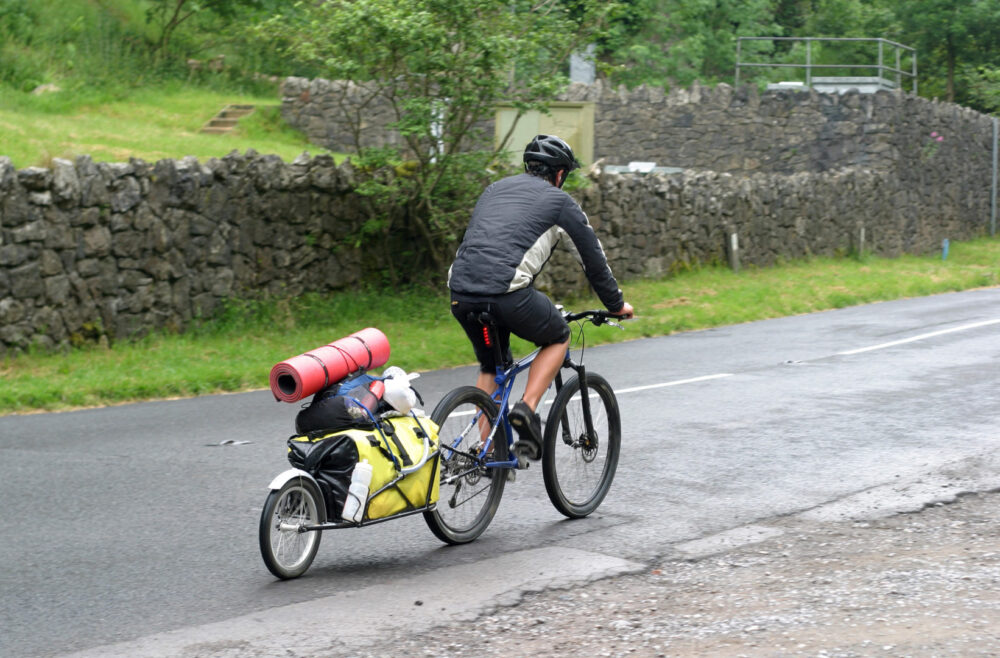Bicycle trailers are fast becoming a viable transportation option in the face of the changing energy scheme. With that, many calls are received at CampfireCycling headquarters about the basics of trailer design. One of the more frequent considerations when selecting a trailer is the wheel count. Are you better off with a one wheel bike trailer or two wheel bike trailers? The choice is dependent on the use. If you intend to have children in-tow, two wheels is the only option. If you need more utility & versatility, your options open to a wide variety of designs.

One wheel designs
In one wheel-designed trailer, the weight of the trailer’s load is shared between its only wheel and the rear wheel of the bicycle. Due to the weight being spread between the bike and the trailer, the rear driving wheel of the bike will be pushed into the ground aiding traction tremendously. When off-road touring or bike-camping, this is a great advantage as steep terrain is amazingly easy to sit and spin up with surprising grip, even with the additional load being towed. Also, the width is an obvious bonus in tight conditions. The compromise, however, is that the handling of the bike changes in direct reflection to the weight of the load. With maximum payloads often being around 100lbs, this can be quite a dramatic difference from the bike alone. Learning to predict the weight shift in tight terrain & quick maneuvering is key as the bike will occasionally try to find its direction.

When using a single-wheel trailer for around-town errands, it’s sometimes difficult to stabilize the entire bike-trailer unit when parking, unless a prop (signpost, etc) or a secondary kickstand is used. These characteristics of single-wheel trailers make them the most efficient design when technical situations such as single-track and narrow pathways are sought, and less ideal for general around-town use if operating space is ample. This video shows a great example of a B.O.B. Ibex single-wheel trailer in its element.
Two-wheeled trailers
On the other hand, two-wheeled trailers rest the majority of their load between their own two wheels. This leaves the rear wheel of the bike, and therefore the handling of the bike itself, relatively unaffected by the added weight. It’s only the weight being pulled that is felt, for the most part. Tire wear should not increase substantially and using a single kickstand is no problem as the bike remains independent of the trailer. The compromise, of course, is the width of the two-wheel design. For any type of technical terrain, or extremely tight areas of operation, this can become overwhelming. Narrow sidewalks and gates can become a real obstacle.

Heavy hauling trailers, especially child trailers, are most often two-wheeled allowing you to distribute the weight over the surface and into two rolling wheels instead of one.
Personal Experience
I’ve used the BOB Yak and several different models of Burleys so I have a good idea of how the different systems handle. A bit of a disclaimer as every trailer will handle differently, especially dependent on how you attach the load.
Good Rule of Thumb
Both setups have their advantages and drawbacks, therefore, your choice will be guided by your needs. Single-wheel bike trailers follow directly in line with your bicycle and are as wide as your bike’s handlebars thus offering agility and manoeuvrability. Two-wheel bike trailers, on the other hand, are more stable in balance but are wide and bulky for city streets or bike paths.
If you are planning to do extensive, off-road single track or narrow technical pathways or otherwise, you’ll want to lean towards a single-wheel trailer. If around-town utility is what you’re going to be looking for, study up on the variety of two-wheeled designs available and keep the load off your bike, and your bike handling, predictable.
Here are some good discussions on the functioning and differences of different trailer styles:
BOB Trailer Review
Practical Pedal’s Trailer Manifesto
What are Your Personal Experiences?
Let us know what style you prefer, and why!